Jellystone RV Park (Sept. 17)
We liked the campsite at Rustico Bay a lot, but since it was the end of their season, we had to move. We decided to go to a Jellystone (a franchise chain) campground very near the Confederation Bridge, to reduce the length of our trip to Nova Scotia when we left. The other main attraction of the campground is that it backs onto a RailTrail.
Unfortunately, the campsites are very narrow, and the person in the office tried to put us right next to another camper who also had a slideout. Given that the place was practically empty, we asked to move. The next day she put another camper (a small one) right beside us. All in all, although the campground was convenient and pleasant, I thought the administration was poor.
As usual, we lost most of the day in the move. However, we took advantage of being on the bike trail to take a trip to Kinkora, about 11 km. Chuck always likes to stop for ice cream during our bike trips, and the town did have a small store. When we got back, I wanted a bit more exercise, so I continued on a few more to the end of the trail. There I found some interpretive signs about the railroad which were quite interesting.
To save money, the rail lines on the island were built as narrow gauge. Since goods were brought by ferry, they had to be loaded onto the cars at the dock, and there was no need to match the wide gauge on the mainland. However, unloading and reloading is time-consuming and expensive, so eventually a rail ferry was added. The rail cars go directly onto the ferry on one end and roll off on the other. The mismatch of the track became a liability, so a third rail was laid in to Charlottetown and Summerside. This meant that the same track could handle both gauges of train car and cargo needed to be reloaded only if it was bound for the smaller markets.
Because PEI is small and the main exports are agricultural, the trains became uneconomical once the trucking became an option. The railway was closed in 1989. And that is why PEI has over 435 km of RailTrail. However, for my biking friends, I have to say that getting your bicycle to PEI presents some challenges. The Confederation Bridge is not bicycle friendly. So, bicyclists either need to arrange for transport across the bridge or take the ferry from Pictou, NS.
The bridge is near Summerside the second largest town in PEI. On Monday we headed for the town, and then up the scenic drive on the northeast cape.
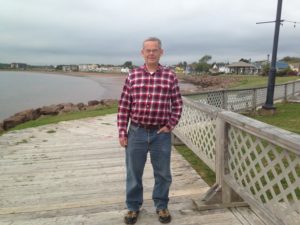
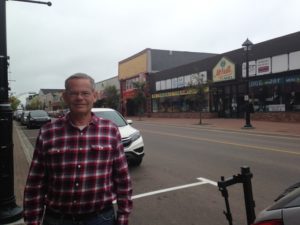 Summerside has about 15000 people, a cute downtown and a boardwalk. One of the features we appreciated downtown was a series of historical plaques giving the family history of some of the town’s founders. We can never pass by a historical marker, and so we read all of them before continuing on to the boardwalk, which also had some reading material.
Summerside has about 15000 people, a cute downtown and a boardwalk. One of the features we appreciated downtown was a series of historical plaques giving the family history of some of the town’s founders. We can never pass by a historical marker, and so we read all of them before continuing on to the boardwalk, which also had some reading material.
We continued onto the North Cape Coastal trail which takes you partly along the coast and partly inland. Needless to say, it is quite scenic. It goes through the Acadian part of PEI, and there are a number of small towns and this large, beautiful church.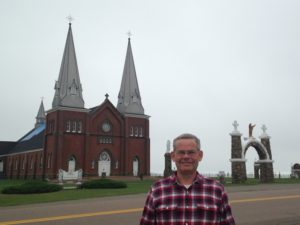
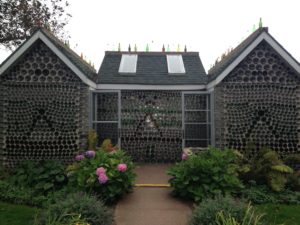
Our first stop was the Bottle Houses at Cap-Egmont. Edouard Arsenault, who had been the resident lighthouse keeper at the Cap-Egmont lighthouse, was inspired by a “bottle house” that his daughter saw on a trip to British Columbia. (That house no longer exists.) In the winter of 1980 he collected and cleaned 12000 glass bottles from local restaurants, bars, etc (no recycling back then) and using concrete built them into the walls of a 6-gabled house. The base of the bottles faced out and the tops face in. The result is very pleasing (as a sculpture.)
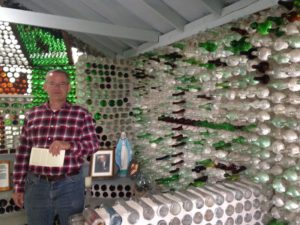 He then proceeded to build a chapel, using votive candle holders for the pews (to the left) and a tavern (below). As far as I know, only the chapel has actually been used as such. He also built a replica of the lighthouse (out of wood) and put in a beautiful garden. The result is an unusual tourist attraction.
He then proceeded to build a chapel, using votive candle holders for the pews (to the left) and a tavern (below). As far as I know, only the chapel has actually been used as such. He also built a replica of the lighthouse (out of wood) and put in a beautiful garden. The result is an unusual tourist attraction.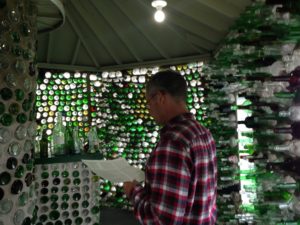
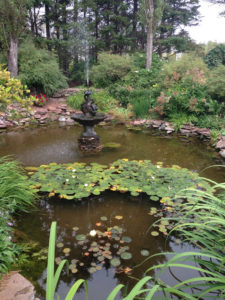
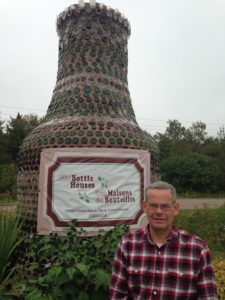 Unfortunately, he used railroad ties for the building foundations, and by 1991 these were beginning to rot. The family decided to preserve the buildings as an attraction, and painstakingly picked all the bottles out of the concrete and rebuilt the buildings on concrete foundations. They also added a huge bottle made of bottles at the roadside (which is good, because otherwise we would have missed it) and a gift shop with lots of feature made from bottles. The whole thing was quirky, but I have to say that the bottle houses have a certain beauty.
Unfortunately, he used railroad ties for the building foundations, and by 1991 these were beginning to rot. The family decided to preserve the buildings as an attraction, and painstakingly picked all the bottles out of the concrete and rebuilt the buildings on concrete foundations. They also added a huge bottle made of bottles at the roadside (which is good, because otherwise we would have missed it) and a gift shop with lots of feature made from bottles. The whole thing was quirky, but I have to say that the bottle houses have a certain beauty.
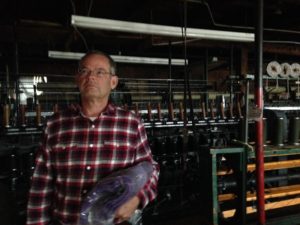 Another interesting stop was the MacAuslander woolen mill at Bloomfield. This factory is the source of the yarns used at the Northern Watter Knitwear Shop and other sweater factories on the island. The machinery is on the ground floor with a small shop in the attic. We were there right before closing, so the machines were not in use, but visitors are welcome to walk around. It looks like what you would imagine a yarn mill might have looked like 100 years ago. The wool comes from local sheep. Washing the wool reduces the weight by 40%, due to the lanolin and dirt in the raw wool. It is then carded, dyed and spun into yarn. The yarn is sold in the shop and other shops on the island. As well, the yarn is woven into blankets, which are now a traditional wedding gift on the island. Both the yarn and the blankets are beautiful but scratchy. I was very tempted to use the yarn for Elisabeth’s poncho, but in the end decided it would be too scratchy for her to wear.
Another interesting stop was the MacAuslander woolen mill at Bloomfield. This factory is the source of the yarns used at the Northern Watter Knitwear Shop and other sweater factories on the island. The machinery is on the ground floor with a small shop in the attic. We were there right before closing, so the machines were not in use, but visitors are welcome to walk around. It looks like what you would imagine a yarn mill might have looked like 100 years ago. The wool comes from local sheep. Washing the wool reduces the weight by 40%, due to the lanolin and dirt in the raw wool. It is then carded, dyed and spun into yarn. The yarn is sold in the shop and other shops on the island. As well, the yarn is woven into blankets, which are now a traditional wedding gift on the island. Both the yarn and the blankets are beautiful but scratchy. I was very tempted to use the yarn for Elisabeth’s poncho, but in the end decided it would be too scratchy for her to wear.
For our last full day on the island, we decided to museum hop. We had passed signs for 2 museums on the North Cape Trail, and so we headed back up the cape. We also had an important piece of family history to explore.
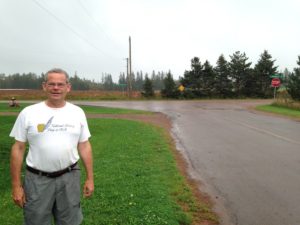 Chuck’s great-great maternal grandfather Gamble grew up in Gambles Corner, PEI. (We do not know if Gambles Corner comes from the family name.) We wanted a photo of the village. Gambles Corner does not appear on any maps of PEI, but Google maps knows where it is.
Chuck’s great-great maternal grandfather Gamble grew up in Gambles Corner, PEI. (We do not know if Gambles Corner comes from the family name.) We wanted a photo of the village. Gambles Corner does not appear on any maps of PEI, but Google maps knows where it is. 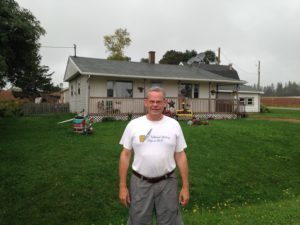
When we got there, there were no signs of a village – only a T-intersection of Rte. 232 and Country Line. There were a couple of prosperous farms and open fields. There was also no sign for Gambles Corner. However, en route we also spotted Millie Gamble Road.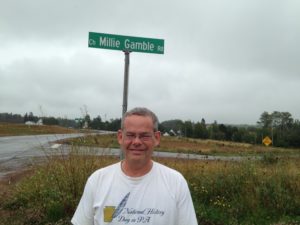
Our first museum was the Acadian Museum which documents the history of the Acadians in PEI. The First Nations Mi’kmaqs were the original inhabitants of PEI. However, Cartier landed there in 1534 and it was claimed by France as a territory in 1604 along with much of the Atlantic coast, including the island which was called Isle St. Jean. The French lived in relative harmony with the Mi’kmaqs. The entire region was called Acadia.
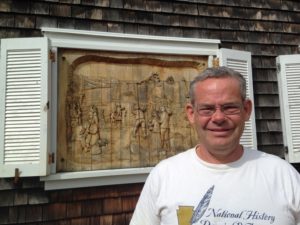 In the mid-1700s, France and England were at war and the area changed hands several times. In 1755, when the conquering British expelled the French Acadians from Nova Scotia, some were scattered among other 13 Colonies and some went to Isle St. Jean. In 1758, the British captured Isle St. Jean and Cape Breton and sent most of their Acadian population back to France. Many of the PEI Acadians died in transit as 3 of the ships sank, taking over 800 unfortunates with them. About 2000 Acadians remained in remote parts of PEI, Nova Scotia, New Brunswick and Quebec. Some of the expelled Acadians had, in fact, been working with the French and Mi’kmaqs against British interests, while others maintained neutrality but refused to pledge an oath of loyalty to Britain. The British did not differentiate.
In the mid-1700s, France and England were at war and the area changed hands several times. In 1755, when the conquering British expelled the French Acadians from Nova Scotia, some were scattered among other 13 Colonies and some went to Isle St. Jean. In 1758, the British captured Isle St. Jean and Cape Breton and sent most of their Acadian population back to France. Many of the PEI Acadians died in transit as 3 of the ships sank, taking over 800 unfortunates with them. About 2000 Acadians remained in remote parts of PEI, Nova Scotia, New Brunswick and Quebec. Some of the expelled Acadians had, in fact, been working with the French and Mi’kmaqs against British interests, while others maintained neutrality but refused to pledge an oath of loyalty to Britain. The British did not differentiate.
However, in 1764 the British relaxed their rules and some Acadians returned to Acadia, while a large contingent moved from France to Louisiana, where they were called “Cajuns”. In 1847, Longfellow published the epic poem “Evangeline” which brought the attention of the European world to the tragedy of the expulsion. There is now a thriving Acadian community on the North East Cape of PEI and many homes fly the Acadian flag (a french tricolor with a star) and send their children to French school. (Since 1967 all Canadians are supposed to have access to French language instruction.) There are about 5000 Acadians in PEI today.
The Acadian Museum focuses on this heritage, both historical and cultural. Although I knew about the expulsion from Nova Scotia, I was not aware of the history of Acadians on PEI. It was very interesting.
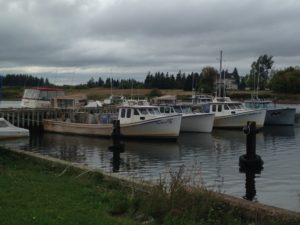 After the Acadian Museum, our next destination was the Shellfish Museum. We were a bit confused about this: according to Google, the original shellfish museum has closed, but another one opened.
After the Acadian Museum, our next destination was the Shellfish Museum. We were a bit confused about this: according to Google, the original shellfish museum has closed, but another one opened. 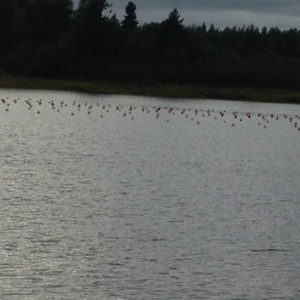 We followed a mix of road signs and Google, getting lost of number of times. We finally came into a small harbor, with lots of small boats and shellfish buoys and a building labelled as Shellfish Museum. However, it was closed – whether permanently or for the season or day was not clear.
We followed a mix of road signs and Google, getting lost of number of times. We finally came into a small harbor, with lots of small boats and shellfish buoys and a building labelled as Shellfish Museum. However, it was closed – whether permanently or for the season or day was not clear.
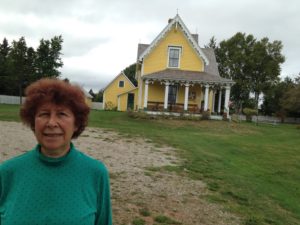 While searching for the Shellfish Museum, we passed a sign for the Parsonage Museum. This turned out to be the parsonage house where L. M. Montgomery lived when she was teaching school. We saw her room, with a fine view of the sea, and toured the house, which is roomy and comfortable. If you recall the incident of the liniment cake in Anne of Green Gables … the incident was inspired by a baking accident that actually occurred in this house.
While searching for the Shellfish Museum, we passed a sign for the Parsonage Museum. This turned out to be the parsonage house where L. M. Montgomery lived when she was teaching school. We saw her room, with a fine view of the sea, and toured the house, which is roomy and comfortable. If you recall the incident of the liniment cake in Anne of Green Gables … the incident was inspired by a baking accident that actually occurred in this house. 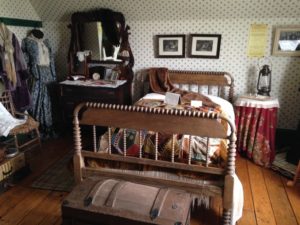
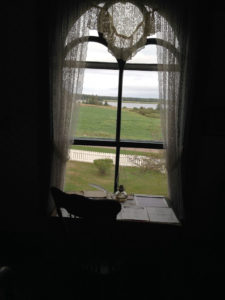
In the evening we went to the McKinnon Family Scottish Ceilidh. It took us a while to find it, because although the sign is on the main highway, it was difficult to spot. This is a long-running Ceilidh, and the family has its own tiny hall for the shows.
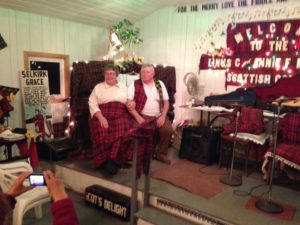
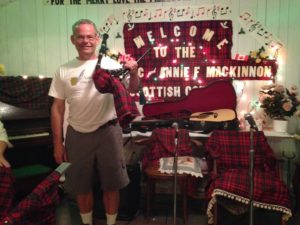 Calling this the McKinnon “Family” ceilidh, is a bit of misnomer now. Cecilia, youngest family member, has been putting on a one-woman show in remembrance of her family since 2007 after her parents passed away and her brother became too ill to perform. She is a wonderful musician and composer, with a lovely singing voice. But it was a bit melancholy with the stage set up for 4 and only her energetic playing to fill it with accordion, bagpipe, fiddle, piano and guitar music, while husband Bill helps out with the practicalities and some jokes.
Calling this the McKinnon “Family” ceilidh, is a bit of misnomer now. Cecilia, youngest family member, has been putting on a one-woman show in remembrance of her family since 2007 after her parents passed away and her brother became too ill to perform. She is a wonderful musician and composer, with a lovely singing voice. But it was a bit melancholy with the stage set up for 4 and only her energetic playing to fill it with accordion, bagpipe, fiddle, piano and guitar music, while husband Bill helps out with the practicalities and some jokes.
We found Cecilia and her husband Bill both to be very nice people, and in the end we stayed and chatted with them for an hour after the performance, discussing everything from life on the island to dogs to Trump. But we could not help but wonder if using her considerable talents and energy working with younger groups who have brought renewed energy to Celtic traditions on the island might be a better tribute to her family. We enjoyed our evening, but came away slightly sad.
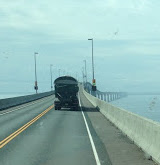 We left PEI on a very calm day. There was no wind, but a slight haze hung over the bridge. Chuck said it reminded him of the song “Bridge to Heaven”.
We left PEI on a very calm day. There was no wind, but a slight haze hung over the bridge. Chuck said it reminded him of the song “Bridge to Heaven”.
